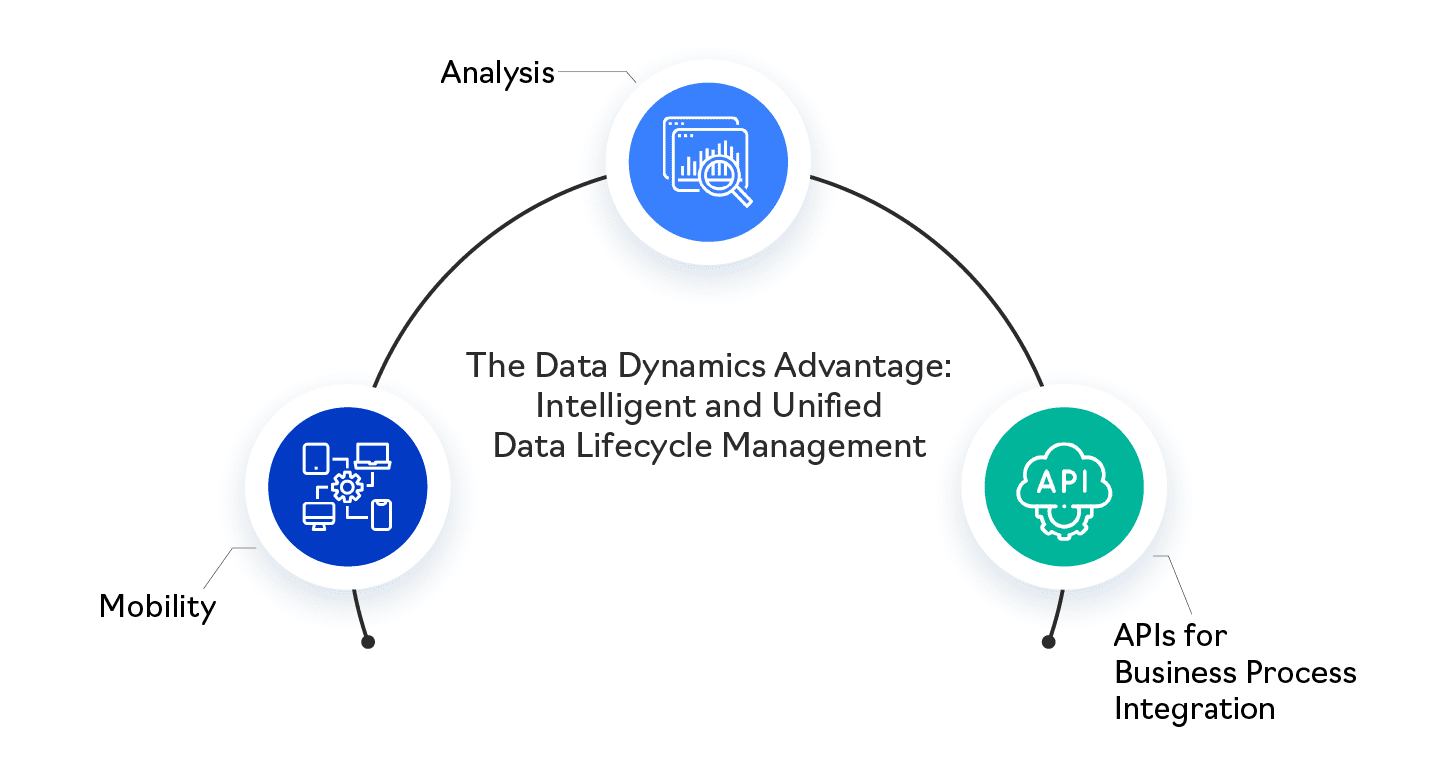In the exhilarating realm of modern business, data reigns supreme. Yet, with the influx of data comes the challenge of managing it effectively—ensuring its security, availability and optimizing its lifecycle. Imagine a world where this challenge is not just conquered but transformed into a strategic advantage. Enter the captivating journey of this Fortune 50 Energy company, where the implementation of Intelligent Big Data Management led to astounding outcomes that rippled across every facet of their operation.
Business Need: A Transformative Approach to Data
A Fortune 50 Energy company was grappling with a common issue faced by many organizations: data chaos. Their data sprawl was growing at an exponential rate, causing storage costs to skyrocket and hampering productivity. With their data spread across various systems, departments, and even remote locations, valuable insights were buried beneath layers of inefficiency. With the goal of reducing costs, increasing productivity, and enhancing data understanding, the need for Data Lifecycle Management was imminent.
Challenges Faced: From Storm to Clarity
In the midst of a data storm, the company faced a complex issue—Unstructured Data Growth and Sprawl, like a wild digital jungle. Amidst this chaos, they discovered hidden risks. Legal and Compliance threats loomed while stressed IT systems struggled with Production, Backup, and HA. Non-Critical Data took undue attention, diverting resources. The lack of data understanding added to the puzzle, causing inefficiencies in data management. Obsolete technology heightened the turmoil, jeopardizing security. Productivity dipped, support costs surged, and vital components became scarce. But amidst these challenges, the company embarked on a journey to bring clarity out of chaos.
The Data Dynamics Advantage: Intelligent and Unified Data Lifecycle Management
Enter Data Dynamics’ Unstructured Data Management platform — an award-winning software helping enterprises gain critical and accurate insights into unstructured file data for accurate storage visibility and infrastructure optimization. This revolutionary platform comprises four modules – Data Analytics, Mobility, Security, and Compliance – and has been proven successful in over 300 organizations, including 28 Fortune 100 and 4 Fortune 500 energy enterprises. It offered an array of robust features that addressed the organization’s pressing needs. It helped them easily categorize, tag, index, analyze, archive, secure, comply and migrate data across multiple sources, providing a structured and refined view of the data that transforms it from mere storage to valuable business assets. Let’s explore some of these transformative capabilities:

1. Mobility:
Navigating the complex world of modern data storage, the Fortune 50 Energy company harnessed the power of the platform’s Mobility module. With automated policy-driven capabilities, the platform became the conductor orchestrating a symphony of data migration. It seamlessly moved data across diverse storage vendors and tiers, adapting to the rhythm of the business and ensuring that information flowed harmoniously to where it was needed most. But the magic didn’t end there— the platform scanned through tens of billions of files, a feat that unraveled the scope of their data landscape, bringing order to the previously chaotic jungle.
2. Analysis:
The platform’s Analytics module, backed by Artificial Intelligence (AI) and Machine Learning (ML), was harnessed to unravel the mysteries within the company’s data trove. AI algorithms were set to task, classifying data with almost uncanny precision. The result? Intelligent identification of sensitive data, a shield against potential breaches. But that wasn’t all—metadata, those often overlooked treasures, were analyzed to unlock the key to storage optimization. This was the moment when data ceased being just data—it became insights, strategy, and potential.
3. APIs for Business Process Integration:
Data management isn’t a siloed endeavor—it’s the heartbeat of every operation. This is where APIs (Application Programming Interfaces) came into play. The company’s data ecosystem seamlessly blended with its business processes. APIs linked systems, turning data management into a collaborative symphony. Workflows were automated, collaboration across teams became effortless, and innovation was ignited. APIs bridged the gap between data and strategy, turning information into action.
Business Impact: Empowering the Future of Data Management

The implementation of a unified data management platform brought about a seismic shift in the way the client managed its data. The results were nothing short of impressive:
1. Mobility and Automation:
- Data Agility: With the Mobility module orchestrating data migrations, the company experienced enhanced data agility. Data was no longer locked in silos; it flowed seamlessly across storage tiers and vendors, aligning with business needs.
- Resource Optimization: Automation liberated IT teams from manual data movement tasks, allowing them to focus on strategic initiatives. This resource optimization led to improved efficiency and innovation.
- Reduced Downtime: Automation reduced the risk of human error during data migrations. The result? Decreased downtime due to migration-related issues, leading to uninterrupted operations.
2. Deep Analysis and Smart Classification:
- Informed Decision-making: AI/ML-driven data classification provided the company with a deep understanding of its data. This knowledge empowered informed decision-making, as they could now differentiate between critical and non-critical data.
- Sensitive Data Protection: The intelligent identification of sensitive data helps the client safeguard critical information. This bolstered their security posture, mitigating potential data breaches and compliance violations.
3. Business Process Integration:
- Operational Efficiency: APIs seamlessly integrate data management with business processes. This streamlined operations, from data movement to decision-making, enabled our subject company to respond swiftly to market changes and customer demands.
- Cross-Functional Collaboration: APIs facilitated cross-functional collaboration by breaking down data silos. This opened up opportunities for teams to collaborate on projects, driving innovation and accelerating time-to-market.
4. Empowered Data Understanding:
- Optimized Resource Allocation: Through metadata discovery and classification, the client gained insights into data usage patterns. This optimization of resource allocation improved storage efficiency, saving costs and enhancing overall infrastructure performance.
- Data Monetization: By understanding their data better, the organization was able to identify data sets that could be monetized. This newfound revenue stream added an unexpected layer of business value.
5. The Symphony of Savings:
- Cost Reduction: Archiving a small percentage of data led to massive cost reductions. For every 1% of data archived, the company saved a staggering $3 million annually. These cost savings directly contributed to the bottom line.
- Efficiency Boost: Infrastructure optimization reduced costs and improved Total Cost of Ownership (TCO). The 59% cost savings in high-risk file storage environments was a testament to the efficiency achieved.
- Enhanced Productivity: The 10x increase in productivity was a transformational outcome. Employees were freed from the burden of manual data management tasks, enabling them to focus on value-added activities.
Conclusion
As the digital landscape evolves, harnessing the power of data becomes a competitive imperative. Embrace these business values as a roadmap to your own transformation. By doing so, you can position your organization as an agile, data-driven leader ready to navigate the complexities of the modern business world. The path to data-driven success starts with Intelligent Data Lifecycle Management. Are you ready to embark on this transformative journey?
Click here to download the case study.
About Data Dynamics
Data Dynamics is a leading provider of unified enterprise data management solutions, helping organizations structure their unstructured data with their Unified Unstructured Data Management Platform. The platform encompasses four modules- Data Analytics, Mobility, Security, and Compliance. Proven in over 28 Fortune 100 organizations, the Platform uses a blend of automation, AI, ML, and blockchain technologies and scales to meet the requirements of global enterprise workloads.
With Data Dynamics, enterprise customers can eliminate the use of individual point solutions with siloed data views. Instead, they can utilize a single software platform to structure their unstructured data, unlock data-driven insights, secure data, ensure compliance and governance, and drive cloud data management. Ultimately, the company’s vision is to help enterprises achieve data democratization so that users, no matter their technical background, can instantly access, understand, and derive maximum insights from unstructured data sprawls.
To learn more, please visit – www.datadynamicsinc.com or contact us at solutions@datdyn.com or call us at (713)-491-4298 or +44-(20)-45520800.






